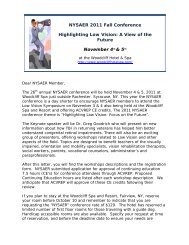Association for Education and Rehabilitation of the ... - AER Online
Association for Education and Rehabilitation of the ... - AER Online
Association for Education and Rehabilitation of the ... - AER Online
Create successful ePaper yourself
Turn your PDF publications into a flip-book with our unique Google optimized e-Paper software.
Family Perspectives on Cochlear Implants<br />
Parent Evaluations <strong>of</strong> Their<br />
Children’s Outcomes<br />
after Implantation<br />
Overall, studies examining families’ evaluations<br />
<strong>of</strong> <strong>the</strong>ir children’s cochlear implants have included<br />
parents’ views <strong>and</strong> satisfaction regarding outcomes<br />
after <strong>the</strong>ir children were implanted (Archbold,<br />
Lutman, Gregory, O’Neill, & Nikolopoulos, 2002;<br />
Nunes, Pretzlik, & Ilicak, 2005). In general, <strong>the</strong>se<br />
evaluations were specific to <strong>the</strong> children’s auditory<br />
perception <strong>and</strong> communication outcomes. Results<br />
indicate that <strong>the</strong> majority <strong>of</strong> parents were highly<br />
satisfied with <strong>the</strong>ir children’s outcomes (Beale,<br />
Shores, & Wood, 2000; Christiansen & Leigh,<br />
2002). These studies focused on families with<br />
children who are deaf.<br />
Approximately 30 to 40 percent <strong>of</strong> children with<br />
sensorineural hearing loss, however, have additional<br />
disabilities (Filipo, Bosco, Mancini, & Ballantyne,<br />
2004). It is, <strong>the</strong>re<strong>for</strong>e, also important to consider<br />
parents’ evaluations <strong>of</strong> outcomes <strong>for</strong> children with<br />
associated, or multiple, disabilities. In general, <strong>the</strong>se<br />
children are reported to show slower gains <strong>and</strong><br />
<strong>of</strong>ten more limited success with oral communication<br />
than <strong>the</strong>ir peers who are solely deaf (Hamzavi,<br />
Baumgartner, Egelierler, Franz, & Schenk, 2000;<br />
Pyman, Blamey, Lacy, Clark, & Dowell, 2000).<br />
Meinzen-Derr et al. (2010) suggest that <strong>the</strong>rapeutic<br />
strategies may need to be implemented to achieve<br />
greater language outcomes. One study included<br />
parent evaluation <strong>of</strong> children with additional disabilities:<br />
Berrettini et al. (2008) investigated cochlear<br />
implantation in children who are deaf with multiple<br />
disabilities (no indication that any <strong>of</strong> <strong>the</strong> 23<br />
participants had vision impairments or blindness).<br />
These researchers speculated that many participants<br />
in <strong>the</strong>ir study experienced positive benefits in<br />
daily life outcomes, even if language <strong>and</strong> speech<br />
outcomes were not as great as those <strong>of</strong> children<br />
who are deaf without additional disabilities.<br />
Numerous studies have been published regarding<br />
<strong>the</strong> efficacy <strong>of</strong> cochlear implants <strong>and</strong> reasonable<br />
expectations <strong>for</strong> postimplant patterns <strong>of</strong> progress <strong>for</strong><br />
children who are deaf. Although very few analogous<br />
data exist regarding children who experience<br />
concurrent vision <strong>and</strong> hearing loss (Dammeyer,<br />
2009), this database is growing. One component <strong>of</strong><br />
this expansion is <strong>the</strong> investigation reported here—<br />
82 | <strong>AER</strong> Journal: Research <strong>and</strong> Practice in Visual Impairment <strong>and</strong> Blindness<br />
results <strong>of</strong> a survey completed by <strong>the</strong> families <strong>of</strong><br />
children with both vision <strong>and</strong> hearing loss. The intent<br />
was to capture in<strong>for</strong>mation regarding family perceptions<br />
<strong>of</strong> <strong>the</strong> cochlear implantation process, related<br />
services, <strong>and</strong> child outcomes that might not have<br />
been captured by <strong>for</strong>mal assessments completed<br />
with <strong>the</strong>ir children.<br />
As <strong>of</strong> December 1, 2008, 763 children <strong>and</strong> young<br />
adults identified as having deaf-blindness in <strong>the</strong><br />
United States were reported to have at least one<br />
cochlear implant (National Consortium on Deaf-<br />
Blindness [NCDB], 2009). This figure represents 7.8<br />
percent <strong>of</strong> <strong>the</strong> total national deaf-blind census (birth<br />
to 21 years <strong>of</strong> age), although not all states have upto-date<br />
data regarding <strong>the</strong> numbers <strong>of</strong> children with<br />
implants. It is estimated that approximately 3,000<br />
children <strong>and</strong> young adults counted in this census<br />
have severe-pr<strong>of</strong>ound hearing loss in conjunction<br />
with vision loss (NCDB, 2009) <strong>and</strong> would, <strong>the</strong>re<strong>for</strong>e,<br />
be eligible <strong>for</strong> implant consideration.<br />
A recent study by Dammeyer (2009) involved five<br />
young children with congenital deaf-blindness <strong>and</strong><br />
who had received a cochlear implant between 26<br />
<strong>and</strong> 50 months <strong>of</strong> age. Parent interviews documented<br />
<strong>the</strong>se children’s primary benefits from<br />
implantation as increased use <strong>of</strong> objects in<br />
interactions with adults, improved attention, <strong>and</strong><br />
increased emotional response. Although <strong>the</strong> number<br />
<strong>of</strong> participants in this study was small, cochlear<br />
implants were found to have a significant effect on<br />
communication <strong>and</strong> social interaction <strong>for</strong> children<br />
who experienced congenital vision <strong>and</strong> hearing loss,<br />
even though <strong>the</strong> children did not develop spoken<br />
language. Consistent with findings <strong>of</strong> parents <strong>of</strong> 23<br />
implanted children who are deaf with additional<br />
disabilities (Berrettini et al., 2008), all parents <strong>of</strong> <strong>the</strong><br />
5 children with congenital deaf-blindness indicated<br />
<strong>the</strong>y would recommend a cochlear implant to o<strong>the</strong>r<br />
families with children who are deaf-blind (Dammeyer,<br />
2009).<br />
This article describes findings from a parent<br />
survey that addressed <strong>the</strong> following questions: What<br />
are families’ experiences with <strong>the</strong> process <strong>of</strong><br />
cochlear implantation (seeking, securing, mapping,<br />
<strong>and</strong> habilitation services) <strong>for</strong> <strong>the</strong>ir child with deafblindness?<br />
What meaningful changes has <strong>the</strong> family<br />
observed in relation to <strong>the</strong> child’s development,<br />
behavior, social interaction skills, <strong>and</strong>/or <strong>the</strong> child’s<br />
participation in family activities?







